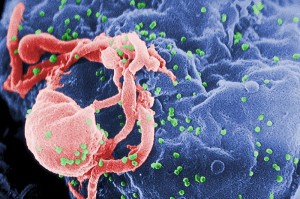Potential HIV Cure Uncovered
Many remedies for diseases have been tested on animals, and this has been the cause of much uproar amongst animal rights activists. Even with evolving technology, this is still the most effective method to date. It’s no doubt sad to see animals have to deal with this, but this kind of experimentation leads to incredible breakthroughs.
Astounde covered a story last month of how scientists had perhaps unlocked the code to combatting seven different types of cancer, as well as lymphoma and leukemia. The treatment effectively stopped the growth of cancerous human tumors that had been implanted in mice. Official human trials are slated for the near future. Another breakthrough of similar significance occurred this week.
HIV is a failure of the immune system to protect against outside threats, often leading to early death (over 30 million known deaths to date). In 2010, there were over 34 million people in the world living with aids; this is almost quadruple what the figures were just twenty years ago. It’s impossible to truly monitor the disease globally, but the implications are far reaching.
In the human body, there are Killer-T cells which fight infection and keep the streets of your body clean. Unfortunately, these guardian cells are limited in number, and aren’t enough to fight off the powerful HIV cells. Scientists were able to clone these Killer-t cells, and fuse them into human stem cells. These stem cells were then administered into mice, who had infected human tissue inside of them. The results were extremely positive. This infusion simulated the combative reaction in a living organism, but the human body is definitely more complicated than that of a rodent.
These stem cells were engineered by a research group at UCLA, and in their trial, successfully targeted and eliminated HIV-contaminated cells inside of mice. Lead Investigator Scott Kitchen, Assistant Professor at the David Geffen School of Medicine said, “We believe that this study lays the groundwork for the potential use of this type of an approach in combating HIV infection in infected individuals, in hopes of eradicating the virus from the body”
Kitchen went on to say, “We believe that this is the first step in developing a more aggressive approach in correcting the defects in the human T cell responses that allow HIV to persist in infected people.”
Long before Magic Johnson brought HIV awareness to the world stage, many tears were shed, emotions uncontrolled, and lives lost because of this disease. The groundwork has been laid, and people with the intellect and drive to make a difference are working their hardest to do just that. HIV is classified as a global pandemic by the World Health Organization; could this be the beginning of the end for this plague?
Comments
Tags: aids cure, cure for aids, cure for hiv, hiv cure
Trackback from your site.



Comments (3)
Maven
| #
Keep us posted, very intriguing!
Reply
steve
| #
Right now there are (as I see it) three distinct avenues advancing towards the goal of a complete cure for HIV/AIDS
1) The CD8 cytotoxic T lymphocytes—the “killer” T cells that are featured in the above article,
2)Efforts by the company Sangamo to create a sythesized version of the mutated gene called CCR5 Delta 32 that offers natural immunity to HIV by treating the persons own blood cells and injecting them back. This is in Phase II human trials now!
3) Drugs that can cause latent HIV to become active: Results showed that the amount of HIV RNA measured in participants’ resting CD4 cells increased an average of five-fold after they took Zolinza. According to the study authors, this indicates that Zolinza successfully reactivated the latent HIV in these cells. There are several drugs in phase II and III trials that may also activate HIV, though more work will need to be done to make them more effective.
I think the best shot at a complete cure for HIV may be a combination of activation as much HIV as possible while ARV kills them, then either modified T-cells or synthesized CCR5 delta 32 cells kill what’s left.
Reply
Mike Awada
| #
@Steve, Thanks for the incredible insight!
Reply